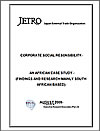BOP Report(Bottom of the Pyramid)
All data are collected in the Fiscal Year of 2008-2009.
13. A BOP Typology
The innovators, actors, and leaders that are emerging in the BOP space fall into seven broad categories, spanning the continuum from private to public sectors. Three of these categories—corporate pure-play experiments, catalysts and enablers, and social entrepreneurs—have particular relevance for companies, and are characterized by their faster-moving entrepreneurial style and motivations. Also mentioned briefly are four other categories whose full exploration lies beyond the scope of this paper.
1) Corporate pure-play experiments:
These projects tend to be 100 percent for-profit businesses, or have the near-term intention of being so. They are the star cases in the BOP literature because they best stick within business managers’ existing frame of reference.
2) Catalysts and enablers:
This diverse group includes everything from academic institutions and think tanks to foundations and NGOs to niche financial organizations and consultancies. These organizations often perform a brokerage function, act as intermediaries, and are highly networked. As such, they are interested in creating the “middleware” to make BOP ideas work, such as new tools, processes, blueprints, and the hard and soft infrastructure for sustaining further marketspace creation. They tend to be small in size and flexible and opportunistic in nature. In terms of funding models, they run the gamut from for-profit to self-financing/sustaining to nonprofit.
3) Social entrepreneurs:
These are actors who are putting their ideas into action in the field and providing services to clients and customers. Most of these organizations are for-benefit6 and have had some government funding and outside help, but often no more than any other for-profit startup. Significantly, some use this initial support to migrate to for-profit organizations. Within these categories are three important subcategories: eco-design and digerati entrepreneurs, the ex-big-business group, and grassroots and national champions.
Four additional categories that will not be explored here in greater depth are:
4) Multilateral institutions and development agencies:
Organizations like the World Bank, the UNDP, and USAID are also important enablers of social entrepreneurship and market creation; they fund many programs and activities that improve the business environment for economic activity. What distinguishes this group from the “catalysts and enablers” group is its slower pace and traditional public-sector approaches to development. Among some senior people, there is notable ambivalence and suspicion about BOP projects—some of which could be attributed to a concern that BOP project might replace the work of governments and development programs. But the biggest question for these institutions and agencies is: How do we make these programs work more effectively, legitimately, and in concert with other sectors and developments? With so much activity in this space, duplication and inefficiency are the norm.
5) Advocates:
NGOs, social activists, and citizen and religious groups have historically been the strongest advocates for remedying the ills and injustices of the world’s poor. In many ways, this group is the most in touch with BOP issues; its members are intensely cause-oriented and mission-driven and thus have a strong normative agenda. Many in this group see business as part of the problem and not the solution, and so the positioning of business as a positive agent of change is often a difficult sell for these folks (OXFAM and Greenpeace are high-profile examples). Of course, many of these groups are also quite pragmatic, blur into the social entrepreneur category, and play a key role in making the BOP work. Developing processes to include these groups is increasingly critical.
“For-benefit” has replaced “not-for-profit” as the term of preference because it is more descriptive and avoids definition by negation.
6) Corporate philanthropy:
Corporate philanthropy is another vector for the BOP. As Michael Porter and Mark Kramer argue, this corporate function is often undervalued and underleveraged, but with the right approach it can be essential to a company’s competitive advantage. While they don’t mention the BOP, their framework clearly applies.
7) Transnational networks:
These networks of nested networks provide global scale and scope to local and regional groups and individuals, mainly through the Web and mobile telephony. Some networks are ad hoc and transient; others are practical and technically focused; still others are designed to support social movements and global causes, as we have seen most powerfully with the anti-globalization coalitions. For example, in Uganda, Woman Information Resource Electronic Services (WIRES) provides technical support for start-up companies. The international movement La Via Campesina coordinates peasant organizations of small and middle-class producers, agricultural workers, rural women, and indigenous communities in Asia, Africa, America, and Europe.
Of course, all of these categories overlap in a dynamic web of collaboration and—while it’s not said in polite company—increasing competition for funding, reputation, and mindshare. So the topography of this web is uneven, with some groups having more power and influence than others. It should also be said that even among collaborations there remains a great deal of creative tension, prejudice, territoriality, and values collision, which makes working on shared issues difficult in practice. “Show me a private-public sector partnership model that works!” is a frequent cry from business managers. A fruitful area of action research, then, is figuring out optimal processes for managing these multi-stakeholder collaborations.
目次
- 1. Reperceiving Business from the Bottom Up
- 2. Bop in Brief
- 3. Four Consumer Tiers
- 4. The Invisible Opportunity
- 5. Tier 4 Pioneer
- 6. Creating Buying Power
- 7. Shaping Aspirations
- 8. Improving Access
- 9. Tailoring Local Solutions
- 10. Putting It All Together
- 11. A Common Cause
- 12. BOP Experiments in the Field
- 13. A BOP Typology
- 14. What's Next for BOP?
- 15. How to Get Started: The Conceptual Framework for BOP Innovation
- 16. BoP Conferences
- 17. Case Studies and Relevant Reference Material
- Bibliography




